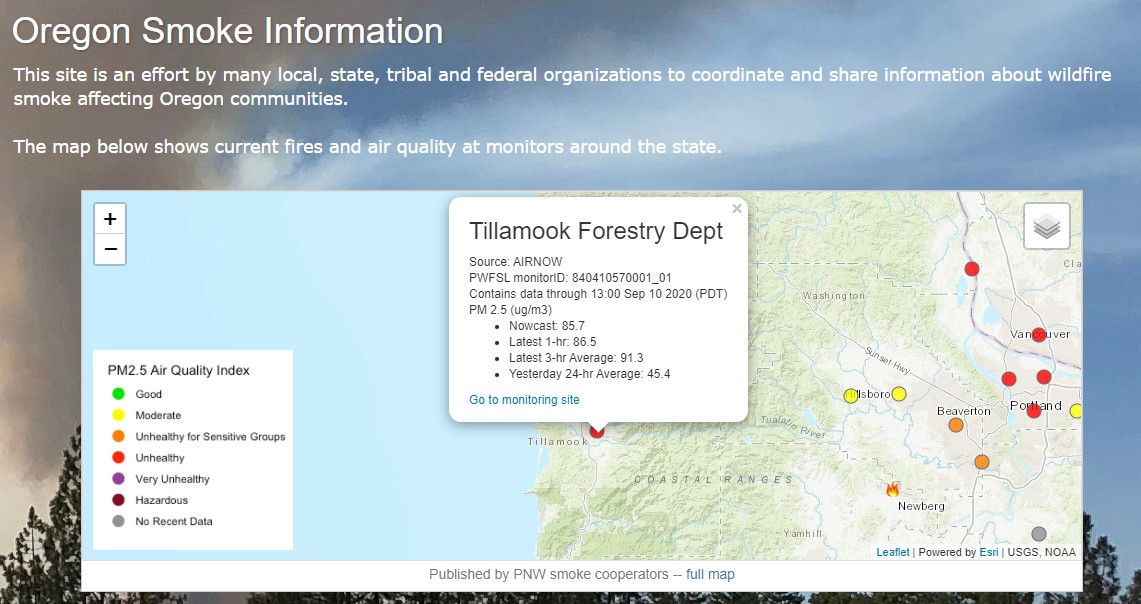EDITOR’S NOTE: Air Quality map shown today September 10th at 3 pm – Unhealthy air quality in Tillamook County.
Statewide, OR—The Oregon Department of Environmental Quality, Lane Regional Air Protection Agency and the Southwest Washington Clean Air Agency extended an air quality advisory Thursday, September 10th for all regions of Oregon and Southwest Washington due to fires in Oregon, Washington and California.
DEQ expects the air quality advisory to last until at least Monday afternoon, September 14th. DEQ and partner agencies will continue to monitor smoke in the state and Southwest Washington.
** Se publicará información en español próximamente **
Smoke levels are fluctuating between unhealthy for sensitive groups (orange) and hazardous (maroon) in these areas. When smoke levels are hazardous everyone needs to take steps to protect themselves. Areas closest to fires – such as Salem, Eugene, the Rouge Valley and Roseburg in Oregon, and Woodland in Washington – are having the worst smoke impacts.
The Portland-Vancouver area will likely have air quality worsen beginning Thursday evening or Friday. Air quality will also likely worsen in Central and Eastern Oregon starting Thursday. The Oregon Coast may see a little air quality improvement starting on Sunday.
Several highways and roads are closed around Oregon. Check TripCheck for the latest information.
Oregon Emergency Management officials are asking the public to only call 911 to request emergency services and not to call 911 to report smoke. The Oregon Health Authority asks the public to refill prescriptions at pharmacies and not to go to emergency rooms to refill them. They also advise that you refill them as early as you can and, when possible, keep extra on hand.
Smoke levels can change rapidly depending on weather. Check current conditions by visiting DEQ’s Air Quality Index or the Oregon Smoke Information Blog, downloading the free OregonAIR app on your smartphone, or going to on the U.S. Environmental Protection Agency’s Air Now.
Smoke can irritate the eyes and lungs and worsen some medical conditions. Young children, adults over 65, pregnant women and people with heart disease, asthma or other respiratory conditions are most at risk.
Protect your health when smoke levels are high:
• Avoid outdoor activities and stay inside if possible. Keep windows and doors closed.
• Be aware of smoke in your area and avoid places with the highest levels.
• Use high efficiency particulate air (HEPA) filters. These can be portable filters or can be installed in indoor heating, ventilation, cooling and air purification systems. You can also create your own air purifying filter by following these easy to follow instructions: DIY air filter factsheet.
• If you have heart or lung disease or asthma, follow your healthcare provider’s advice.
• Consider leaving the area if smoke levels are hazardous and you have heart disease, asthma or other respiratory conditions. Otherwise, please wait to be directed to evacuate. Pay attention to evacuation notices. If you choose to leave the area, remember to take face coverings and hand sanitizer with you to help protect yourself and others from COVID-19.
Cloth, dust and surgical masks don’t protect from the harmful particles in smoke. N95 respirators that are tested to ensure proper fit and that are worn correctly may provide protection. Otherwise, they might just provide a false sense of security. They are not available in children’s sizes and are not recommended for strenuous activities. N95 respirators are in limited supply due to COVID-19. Additional information on wildfire smoke and COVID-19 can be found on the Centers for Disease Control webpage .
DEQ’s color-coded Air Quality Index provides current air quality conditions and ranks air quality as follows: Green is good. Yellow is moderate. Orange is unhealthy for sensitive groups such as children, seniors, pregnant women and those with respiratory conditions. Red is unhealthy for everyone. Purple is very unhealthy for everyone. Maroon is hazardous.
Find more information: Oregon Smoke Blog


.png)